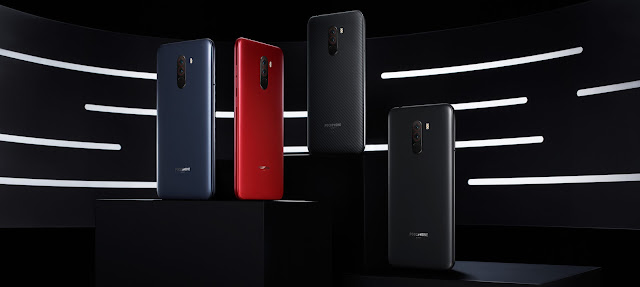 |
| Pocophone F1 Official Shot |
Anda berbicara Bahasa Indonesia? Baca artikel terjemahannya di sini!
The Pocophone, without a doubt, is the most intriguing device of 2018. Don’t get me wrong, there are plenty of unique devices throughout 2018, such as the Vivo NEX, Oppo Find X, etc. However, The Pocophone F1, in my opinion, is the one which turned the most heads. It may not bring the most innovative design, but it brings the most interesting pricing.
Luckily, I had the chance to try it out for about a month. My initial impression was that this phone could be the game changer in the ever-more-expensive smartphone market. Was it justified? Keep scrolling to find out!
Pocophone F1: Design and Packaging
 |
| Nice black and yellow box |
From the box alone, you’re already told that Xiaomi is the one behind the Pocophone brand, which explains the aggresive pricing. Flip the box, and you’ll see this phone offers a lot for the money. Don’t worry, we’ll get through them later.
 |
| What you are getting for your money |
Open the box, and you’ll have an almost-complete package:
- The phone itself
- USB-A to USB-C cable
- QuickCharge 3.0-capable power adapter
- Transparent soft case
- SIM ejector
- Warranty card and quick start guide
You don’t get a pair of headset, but that’s been the norm for Xiaomi phones for a while. Even their flagships don’t give you headphones.
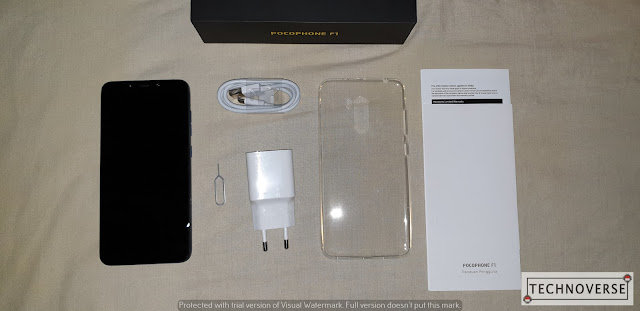 |
| What’s inside the box |
My unit is steel blue in color. There’s this new strange-but-welcome trend for colors in smartphones. It’s refreshing to see more phone colors besides black, white, and gold.
The phone adopts a full-screen design (I refuse to call them bezel-less) with a notch and a chin. It’s not the most beautiful design, sure, but it works. The notch houses an IR camera, selfie camera, earpiece/second speaker, ambient light and proximity sensors. There’s a small LED notification light below the display.
 |
| Notched, full-screen display |
 |
| The notification LED light |
The back case is made of polycarbonate. A few years ago, the material was considered cheap, but to be honest, after handling many phones with slippery glass back, I’d say this material is fine. It could’ve been metal, but for what they’re asking, I guess it’s fine. At least they don’t use that awful-slippery cheap thin plastic Samsung used on their older flagship phones…
Anyway, enough materials. The back houses the dual camera setup accompanied with the dual-tone LED flash, as well as the circular fingerprint sensor.
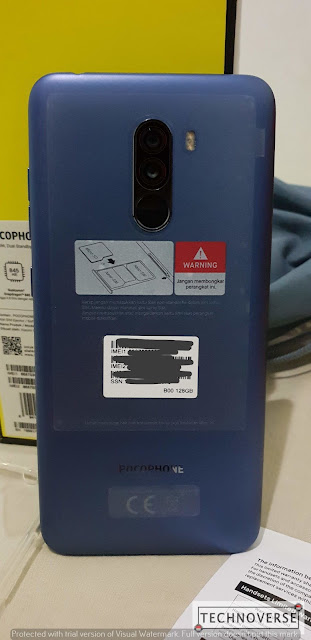 |
| The back side |
The bottom side, as usual hides the second speaker and the USB C port. Yes, there are two speaker grilles, but as usual for phones with similar setup, the other grille houses the microphone.
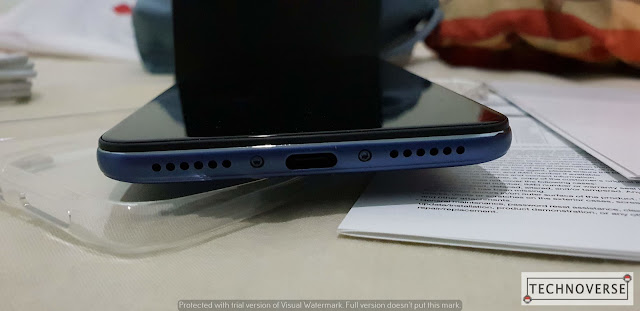 |
| Speaker, microphone, and USB-C port |
The top side houses the increasingly-scarce 3.5mm headphone jack and another microphone.
 |
| Headphone jack is still there |
The right side is where all the buttons are: volume rockers and power/sleep button.
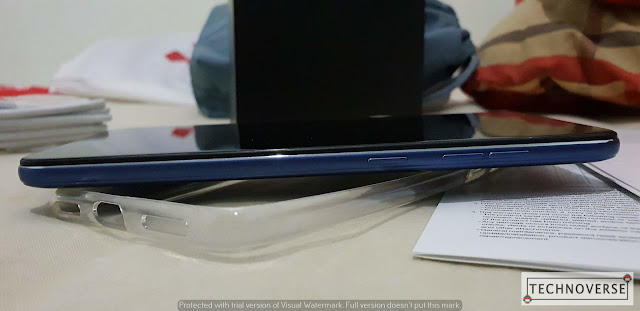 |
| All the buttons are placed on the right side |
 |
| Nothing but the SIM tray on the left side |
Finally, the left side houses the hybrid SIM tray. Yes, Folks, even though the Pocophone F1 supports external storage, you’ll have to choose between second SIM card or external storage. Both SIMs are nano, though.
 |
| The hybrid SIM card tray |
Well, at first glance, the Pocophone F1’s design might not turn any heads, but it works. Out of the box, you’ll have everything you need.
Pocophone F1: Display
Let’s start with the first and foremost aspect: display. The Pocophone F1 is equipped with bright FHD+ (2246×1080), 6.18″ IPS LCD display.
Having a notch means you’ll have limited notification areas. As far as I know, there’s no way to hide the notch, for now. There’s something that bothers me, though: The top left and right radius don’t seem equal. I don’t know, here’s the picture of it below. I know this seems small, but I just can’t unsee it.
 |
| Am I the only one that sees this? |
Beyond that, the LCD seems to be okay. You’ll have to live with the notch but don’t worry, you’ll get used to it.
Pocophone F1: Performance
The Pocophone F1 is equipped with Snapdragon 845. Yes, Folks, the same chipset among flagships such as Google Pixel 3 (XL), LG G7, Galaxy S9(+), Galaxy Note 9, OnePlus 6T, etc. So, the performance here is going to be amazing.
 |
| The specs of my review unit, before Pie update came |
 |
| Sensors in the Pocophone F1 |
My unit just recently got the Android Pie update (good job, let’s see how long they can deliver timely updates!), and the update seems to have improved its performance further.
 |
| Stock results out of the box |
 |
| Results after the first update |
 |
| Results after the Pie update |
For those who doesn’t care about benchmarks, real life usage has been impressive as well. I haven’t found any hiccups and stalls throughout my usage.
CPU aside, my review unit is the 6/128 variant, meaning it has 6GB of RAM and 128 GB of UFS2.1 storage, meaning that file transfers and storage performance should be fast.
Factory resetting after the Pie update reveals that Pocophone F1, on idle, consumes ~1.7GB of RAM and ~10.69GB of storage. That leaves you with ample space to load apps and multitasks.
 |
| Storage usage after factory reset after Pie update |
Then there’s the so-called LiquidCool technology, which puts a large copper vapor chamber inside your phone. In reality, this really helps with the phone’s thermal. I’ve run 3D games, Antutu Benchmark, and the phone only got warm at worst.
Additionally, the Pocophone F1 has a stereo speaker. One speaker is in the earpiece, and the other is on the bottom of the phone. Though stereo, the volume on each speaker is not equal, even though the separation is clearly present.
Pocophone F1: Battery
And here’s another strong point for this affordable phone: battery. The phone’s massive 4,000mAh battery is enough to get me through the day. Even if it’s not enough, the included adapter is QuickCharge 3.0-capable and so does the phone. Much better than the other brand which leaves you to buy your own quick charger.
 |
| Using the included power adapter |
In reality, the QuickCharge 3.0 delivers approximately 2.7A in 4V. This may vary depending on your adapter and jack, but the conclusion stays: It’s fast.
Pocophone F1: Camera
The Pocophone F1 is fitted with dual cameras on the back: 12MP f/1.9 Dual Pixel with 5MP f/2.0. The secondary sensor isn’t telephoto, and only serves as the depth sensor for those blur portrait-mode effects. For the uninitiated, Dual Pixel autofocus enables fast and accurate focusing on moving objects, much faster than Phase Detection Auto Focus (PDAF). None of the sensors has OIS.
I’ll let you judge the camera quality yourself. Here are some image samples taken with Pocophone F1’s rear camera:
 |
 |
 |
 |
And here are some samples in low-light:
 |
 |
 |
As for the front camera, it’s a 20MP unit equipped with IR for face unlock in complete darkness. Like most front cameras, this one doesn’t have autofocus.
Conclusion
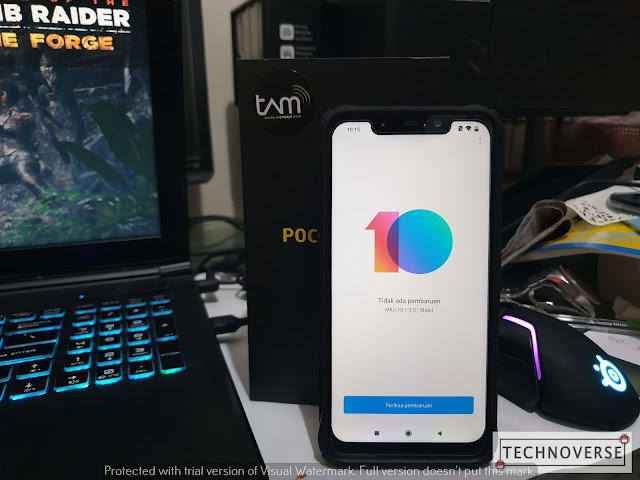 |
| The Pocophone F1 offers one heck of a performance for the price |
The Pocophone F1 is indeed a phone geared towards those who wants to squeeze as much performance as possible for the least amount of buck… And I’d say it works. Xiaomi made some right sacrifices in non-important areas. For at least IDR 4,600,000, you can get a smartphone with flagship specs, excellent cooling… and okay for everything else.
So yeah, if you’re in the market for a high-performance phone but don’t want to pay too much for it, this phone is for you. Just expect that there would be sacrifices in some areas.
Pros
- Affordable with flagship specs
- USB-C with QuickCharge 3.0
- Excellent Cooling
Cons
- Unbalanced stereo speakers
Well, I guess that’s all for this review, Folks. I’m currently coming up with a new review format, since it’s been quite a long while since my last review. As usual, if you have any questions, I’ll do my best to answer them, as my time with the Pocophone F1 is limited. Finally, thanks for reading and see you in the next article. Happy holidays! 😀
